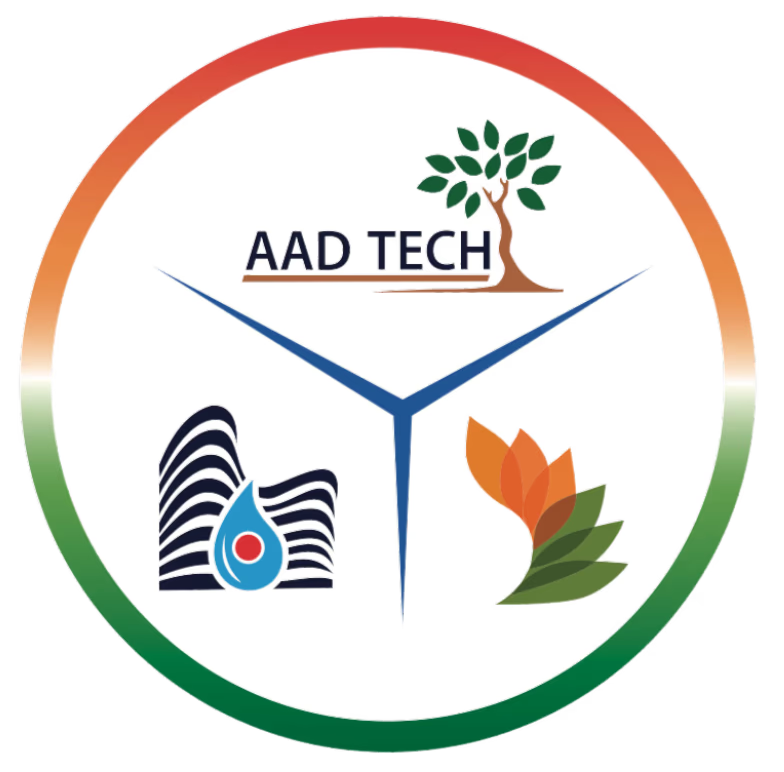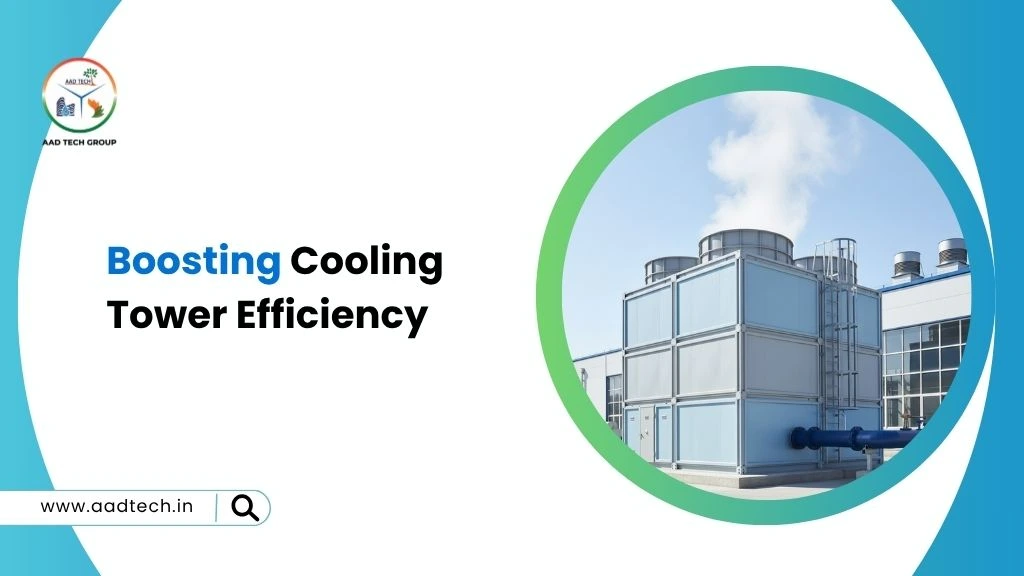Industrial cooling towers play a critical role in maintaining stable temperatures across manufacturing operations, chemical processes, pharmaceuticals, HVAC systems, and energy plants. As towers age, fouling, scaling, drifting, and mechanical deterioration slowly reduce performance which leads to higher energy bills and reduced cooling capacity.
Improving cooling tower efficiency does not always require a major rebuild. In most facilities we support at Aad Tech, efficiency can be restored through a combination of cleaning, mechanical upkeep, and targeted retrofits. Below are the most effective ways to improve cooling tower performance.
1. Improve Water Distribution Over the Fill
Heat rejection starts with water spreading evenly across the fill. When nozzles clog or spray patterns deteriorate, the effective heat-transfer area drops, directly increasing approach temperature (CTI, CTP-122).
To maintain uniform water distribution:
- Clean spray nozzles regularly
- Inspect header pressure and flow
- Replace worn or scaled nozzles
Even water coverage ensures the tower uses the full thermal potential of its fill media.
2. Keep Fill Media Clean and Functional
The fill provides the evaporation surface where most cooling happens. CTI notes that fouled or clogged fill can reduce evaporation effectiveness significantly (CTI, CTP-122).
Fill performance improves when facilities:
- Clean the fill during shutdowns
- Remove sludge, silt, biological growth, or mineral scale
- Replace brittle, warped, or heavily fouled fill blocks
Well-maintained fill restores proper airflow and heat transfer.
3. Optimise Fan and Motor Performance
Cooling tower fans are responsible for pulling large volumes of air through the fill. If fan speed drops or motor efficiency declines, the tower’s thermal capability decreases.
Regular inspection should include:
- Fan blade pitch and alignment
- Gearbox lubrication and bearing condition
- Motor vibration and noise
- Belt/coupling alignment
Stable airflow equals stable cooling tower performance.
4. Maintain Basin Cleanliness and Drift Eliminators
Sediment and biofilm in the cold-water basin reduce pump efficiency and increase the risk of microbiological contamination. Drift eliminators, when clogged, increase water loss and restrict airflow.
Recommended practices:
- Remove sludge, algae, and deposits from the basin
- Ensure drift eliminators are clean and correctly installed
- Keep louvers free from scale and debris
A clean tower circulates water more efficiently and reduces drift loss.
5. Maintain Proper Water Chemistry
Scaling, corrosion, and biological fouling are the top three causes of cooling tower efficiency loss (Nalco, Cooling Tower System Guide).
Effective water chemistry management includes:
- Monitoring pH, hardness, conductivity, and alkalinity
- Using corrosion and scale inhibitors
- Maintaining correct blowdown to manage concentration cycles
- Applying biocides to control microbial growth
Balanced water protects both thermal performance and tower life.
6. Use VFDs to Control Fan Speed and Save Energy
Most industrial cooling towers run at full fan speed even when cooling demand is lower. The U.S. Department of Energy identifies VFDs as one of the highest-impact upgrades for reducing tower energy consumption.
Benefits of VFD integration include:
- Lower energy use during light-load conditions
- Improved temperature stability
- Soft-start capability for reduced mechanical stress
- Quieter operation
VFDs enable real-time matching of cooling capacity to process demand.
7. Conduct Regular Performance Audits
Cooling towers can lose efficiency slowly over time, making it difficult to notice performance drops. A detailed performance audit helps identify the root causes of poor cooling, such as inadequate airflow, fouled fill, or poor water distribution.
A thorough audit evaluates:
- Approach temperature
- Evaporation effectiveness
- Airflow rates
- Fan and motor efficiency
- Structural integrity of the tower
Routine audits ensure your cooling tower continues to operate as designed, even as environmental and process conditions change.
8. Consider Targeted Retrofit Upgrades
If the tower is structurally sound but underperforming, targeted retrofits can extend equipment life and improve efficiency.
Upgrades with strong ROI include:
- High-efficiency fill
- Low-pressure-drop drift eliminators
- New aerodynamic fan blades
- VFD-controlled motors
These improvements deliver measurable gains in energy efficiency and cooling capacity.
Learn more about the key benefits of cooling towers in the manufacturing industry.
Conclusion
Enhancing cooling tower efficiency is a combination of proper water treatment, mechanical upkeep, and modern energy-saving upgrades. Even smaller improvements such as cleaning spray nozzles or adjusting fan pitch can produce measurable reductions in energy use and improve cooling capacity.
At Aad Tech, we support industrial clients by delivering audits, cleaning programs, mechanical servicing, and performance-improving retrofits designed to extend cooling tower life and reduce operating costs.
Frequently Asked Questions
Fouled fill, clogged nozzles, and poor airflow typically cause the largest performance loss.
Twice a year is standard, but dusty or hard-water environments require more frequent cleaning.
Yes. VFDs reduce fan speed based on real-time load, lowering electricity use.
The scale acts as insulation, reducing heat transfer from water to air.
Yes, we offer fill upgrades, fan retrofits, VFD installation, structural restoration, and full tower refurbishment.

